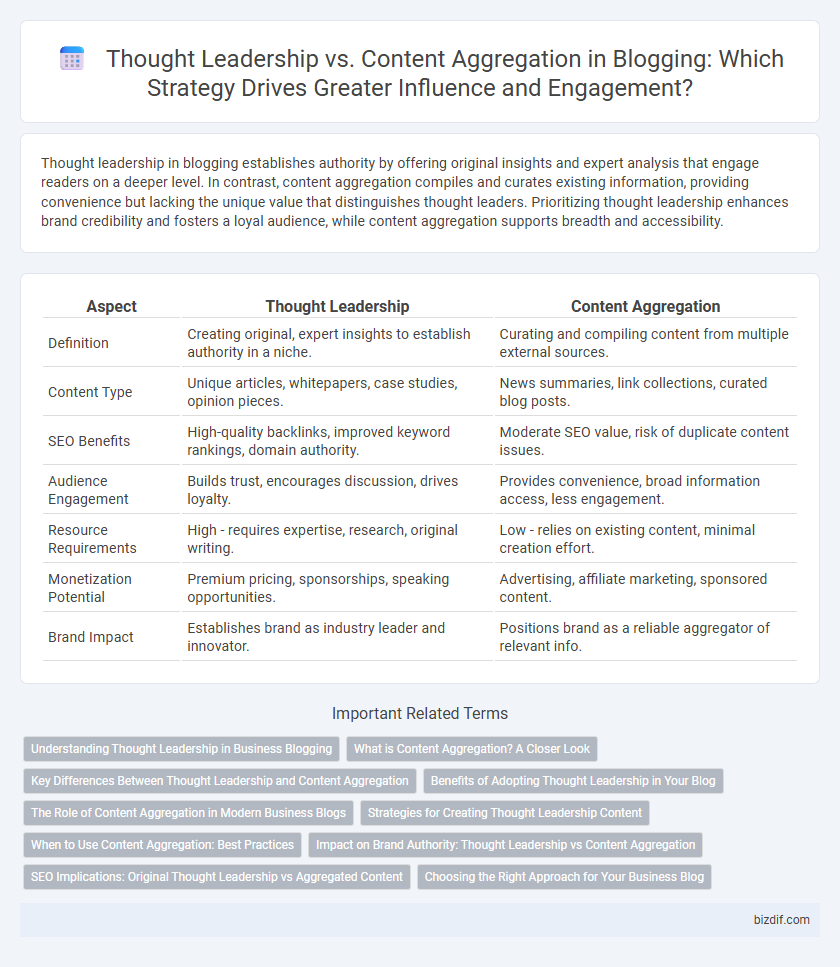Thought leadership in blogging establishes authority by offering original insights and expert analysis that engage readers on a deeper level. In contrast, content aggregation compiles and curates existing information, providing convenience but lacking the unique value that distinguishes thought leaders. Prioritizing thought leadership enhances brand credibility and fosters a loyal audience, while content aggregation supports breadth and accessibility.
Table of Comparison
| Aspect | Thought Leadership | Content Aggregation |
|---|---|---|
| Definition | Creating original, expert insights to establish authority in a niche. | Curating and compiling content from multiple external sources. |
| Content Type | Unique articles, whitepapers, case studies, opinion pieces. | News summaries, link collections, curated blog posts. |
| SEO Benefits | High-quality backlinks, improved keyword rankings, domain authority. | Moderate SEO value, risk of duplicate content issues. |
| Audience Engagement | Builds trust, encourages discussion, drives loyalty. | Provides convenience, broad information access, less engagement. |
| Resource Requirements | High - requires expertise, research, original writing. | Low - relies on existing content, minimal creation effort. |
| Monetization Potential | Premium pricing, sponsorships, speaking opportunities. | Advertising, affiliate marketing, sponsored content. |
| Brand Impact | Establishes brand as industry leader and innovator. | Positions brand as a reliable aggregator of relevant info. |
Understanding Thought Leadership in Business Blogging
Thought leadership in business blogging establishes authority by providing original insights, deep expertise, and forward-thinking perspectives that resonate with target audiences. It drives trust and brand loyalty by delivering high-quality, meaningful content that addresses industry challenges and innovation trends. Unlike content aggregation, which curates existing information, thought leadership creates unique value and positions a brand as a visionary leader within its niche.
What is Content Aggregation? A Closer Look
Content aggregation involves collecting and curating content from various sources to provide a comprehensive overview on a specific topic. This method enables bloggers to offer diverse perspectives and timely information without creating original content. Unlike thought leadership, which emphasizes unique insights and expertise, content aggregation prioritizes accessibility and breadth of information.
Key Differences Between Thought Leadership and Content Aggregation
Thought leadership creates original insights and expert opinions that establish authority within a niche, while content aggregation curates existing information from various sources without adding unique perspectives. Thought leaders influence audience thinking and drive innovation by sharing authentic, data-backed expertise, whereas aggregators primarily provide convenience by compiling relevant content into one place. The key difference lies in originality and value creation, with thought leadership emphasizing thought-provoking analysis and aggregation focusing on efficient content collection.
Benefits of Adopting Thought Leadership in Your Blog
Adopting thought leadership in your blog establishes authority and builds trust by providing unique insights and expert perspectives that resonate with your audience. It drives higher engagement and organic traffic by delivering original, valuable content that differentiates your blog from competitors relying on content aggregation. Thought leadership also attracts quality backlinks and fosters meaningful industry connections, enhancing your blog's credibility and long-term growth potential.
The Role of Content Aggregation in Modern Business Blogs
Content aggregation plays a crucial role in modern business blogs by curating relevant information from diverse sources to provide readers with comprehensive insights. It enhances thought leadership by complementing original content with timely, industry-specific updates that establish authority and trust. Effective aggregation strategies increase engagement and drive traffic by offering valuable resources without overwhelming audiences.
Strategies for Creating Thought Leadership Content
Developing thought leadership content requires in-depth industry knowledge, original insights, and a clear voice that establishes authority and trust. Prioritize creating well-researched, innovative articles that address complex challenges and offer unique perspectives rather than simply compiling existing information. Engaging storytelling, data-driven analysis, and consistent publishing are essential strategies to position yourself as a trusted expert and influence your target audience effectively.
When to Use Content Aggregation: Best Practices
Content aggregation is best used when curating diverse, high-quality information from reputable sources to provide value without extensive original research. Leveraging tools like RSS feeds and social media monitoring ensures timely updates and comprehensive coverage of niche topics. Maintaining clear citations and adding unique insights enhances credibility and SEO performance in content aggregation strategies.
Impact on Brand Authority: Thought Leadership vs Content Aggregation
Thought leadership significantly boosts brand authority by showcasing unique insights, expert opinions, and original ideas that position a brand as an industry authority. Content aggregation, while useful for gathering relevant information, offers limited impact on brand credibility because it primarily republishes existing content without adding distinct value. Brands emphasizing thought leadership experience increased trust, higher engagement, and stronger influence compared to those relying mainly on content aggregation.
SEO Implications: Original Thought Leadership vs Aggregated Content
Thought leadership drives SEO by generating original, authoritative content that attracts backlinks and establishes credibility, improving search rankings. Content aggregation, while useful for summarizing industry news, often suffers from duplicate content issues that can dilute SEO value and reduce organic traffic. Prioritizing unique insights and in-depth analysis in blog posts enhances domain authority and user engagement more effectively than simply compiling external sources.
Choosing the Right Approach for Your Business Blog
Thought leadership in business blogging establishes authority by providing original insights and expert analysis, attracting a dedicated audience seeking unique perspectives. Content aggregation, by contrast, curates relevant industry information from multiple sources, saving time while offering a broad overview but risking less engagement due to repetitiveness. Selecting the right approach depends on your brand's goals, target audience, and resources, with thought leadership driving long-term credibility and content aggregation supporting scalability and topical relevance.
Thought Leadership vs Content Aggregation Infographic

 bizdif.com
bizdif.com